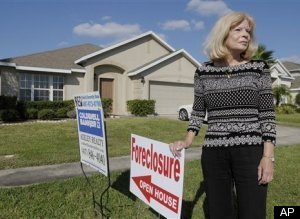 Dick Parsons,the chairman of Citigroup,primarily blamed borrowers for buying houses or taking out home-equity loans they couldn't afford that lead to the burst in the housing market.He didn't mention the financial innovations all designed to maximize fees on the backs of those same consumers.Subprime mortgages were given to low or unstable income individuals who were less qualified than conventional ones.The 100% nonrecourse mortgage(no down payment),teaser rate mortgage(temporary low rates that exploded after a few years), and liar loans(falsified income by brokers) all contributed to a stampede of new scams to get consumers to buy their products.Many of these consumers trusted the advice of brokers and lenders who told them that the price value of their houses would increase yearly and could afford monthly payments.Banks exploited the poor and uneducated consumers and didn't care if they could pay the loans back because they were repackaging them as securities to sell to investors here and abroad. Home owners were also encouraged to refinance their loans to get cash to buy other consumer products.Some did so thirteen times in six years with no documentation of income.Each refinance brought considerable fees.
Dick Parsons,the chairman of Citigroup,primarily blamed borrowers for buying houses or taking out home-equity loans they couldn't afford that lead to the burst in the housing market.He didn't mention the financial innovations all designed to maximize fees on the backs of those same consumers.Subprime mortgages were given to low or unstable income individuals who were less qualified than conventional ones.The 100% nonrecourse mortgage(no down payment),teaser rate mortgage(temporary low rates that exploded after a few years), and liar loans(falsified income by brokers) all contributed to a stampede of new scams to get consumers to buy their products.Many of these consumers trusted the advice of brokers and lenders who told them that the price value of their houses would increase yearly and could afford monthly payments.Banks exploited the poor and uneducated consumers and didn't care if they could pay the loans back because they were repackaging them as securities to sell to investors here and abroad. Home owners were also encouraged to refinance their loans to get cash to buy other consumer products.Some did so thirteen times in six years with no documentation of income.Each refinance brought considerable fees.What happened to traditional banking?After the great depression,regulation ensured that the banks didn't take excessive risks.Banks loaned in the community they did business in and require a 20% down payment.If the loan couldn't be repayed, the bank was responsible and took the asset into its management.With FDIC and a rush to deregulate, incentives and opportunities for bad behavior multiplied. The repeal of the Glass-Steagall Act in 1999,integrated investment and commercial banking and set the stage for exploitation.The banks also got so big they knew the government would bail them out for their bad innovations and behavior.
The innovative products were designed to manage and take away risk as much as possible and to generate fees.Alan Greenspan in 2004 favored adjustable rate mortgages due to his lowering the interest rate to 1% in 2003.Many individuals bought into his advice only to see the rate rise to 5.25 by 2006.Unfortunately,many took out mortgages that overwhelmed them when the payments increased dramatically.Many mortgage brokers received kickbacks from the lenders and became part of the predatory lending system.The brokers got the biggest rewards for steering borrowers into the riskiest mortgages(adjustable-rate loans with prepayment penalties).Innovation responds to incentives and those incentives created products that generated fees that didn't manage risks properly.
Securitization diversified and shared the risks.Banks bundled numerous mortgages and sold them to investors (many to international investors)and pension funds.The credit rating agencies were part of the scam and received their fees to look the other way.When the bubble burst and unemployment rose,the banks knew they would be protected but the unfortunate citizens who believed the advice of the financial experts were left on the street looking for shelter.
More from "Freefall" in the days ahead.
No comments:
Post a Comment